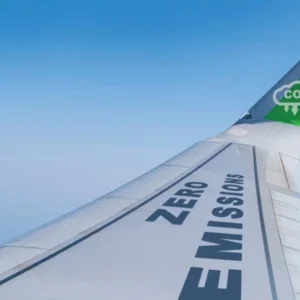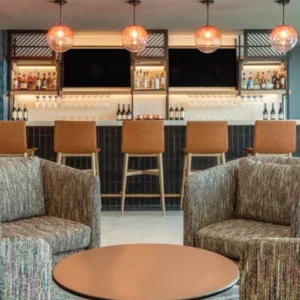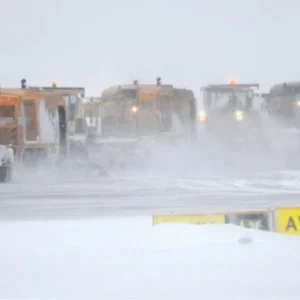
It happens to the best of us. Getting right up to the security lane, placing your carry-on in the tray and walking through the scanners, only for your luggage to be flagged and pulled aside. The reason? That can of deodorant you packed in a rush before heading out – well, it was more than the 100ml allowed. Alternatively, many are familiar with the struggle of removing your laptop and other electronics from an already-overstuffed bag, a Herculean task second only to the challenge of getting it back in without emptying everything out first.
However, this scenario may soon be consigned to the past – in UK airports, at least. The UK government is considering a roll-out of high-tech 3D scanners across the nation by mid-2024, according to a BBC report in November. The equipment, similar to the computed tomography (CT) scanners used in hospitals, provides security staff with a clearer picture of a bag’s contents compared with the conventional security X-ray machines that are currently in use.
The current liquid restrictions have been in place for over 16 years, allowing passengers to carry liquid in containers of no more than 100ml, which must be shown to security staff in a single transparent and resealable plastic bag capable of holding no more than a litre and measuring roughly 20cm by 20cm.
These limits were first introduced across the globe in November 2006, ending a blanket ban on liquids in the cabin brought in during August of the same year, after British police uncovered a transatlantic plot to blow up as many as ten aircraft using explosives hidden in soft drinks bottles. Initially, no liquids at all could be brought in hand luggage – apart from baby milk, which had to be tasted by a parent in front of security staff – but these rules were eased when passenger numbers dropped significantly in response.
Precision imaging
The new CT scanning technology allows security workers to zoom in on a bag’s contents and rotate the images for inspection. It first began to make headlines all the way back in 2017, in pre-pandemic times, when the scanners were trialled at London’s Heathrow Airport, among others. In 2019, Heathrow announced that it would invest £50m in a gradual roll-out of the technology with a deadline of 2022, though this would later be pushed back due to the effects of the pandemic.
“We are slowly rolling them out,” said Heathrow CEO John-Holland Kaye to The Times in November, with regard to the CT security scanners. “We have just started the expansion of the security area in Terminal 3, which will have more CT scanners and have a deadline of mid-2024 from the [Department for Transport]. By then, the normal passenger experience will be that liquids stay in bags.”
The technology has already been in use at US airports, such as Atlanta’s Hartsfield-Jackson and Chicago’s O’Hare, along with Helsinki Airport and Amsterdam’s Schiphol in Europe, for a number of years. More recently, in October 2021, Shannon Airport in Ireland announced its own CT scanning security system, installed at a cost of €2.5m.
“It is one of the projects Shannon Group took on during the period of severe travel restrictions on aviation,” Nandi O’Sullivan, the group’s head of communications, told CNN Travel in May. The scanning system was implemented during the Covid-19 pandemic, but only gained wider attention after international travel resumed. Donegal Airport in the north-west of Ireland has also moved to install this technology and dropped the 100ml rule.
Similar to the CT scanners used in hospitals, these airport security scanners replace the previous 2D X-Ray scanning technology with more precise 3D imaging. “You can get a lot of information from a 2D image, but if you’ve got a 3D object in your hand you get a lot more information,” said Kevin Riordan, head of checkpoint solutions at Smiths Detection, which provided Shannon Airport’s CT scanning equipment, to CNN Travel. “From a security point of view, they’re able to make very accurate decisions about what the materials are in your bag: is it a likely threat material or is it benign. That’s better security, better decisions.”
Upon implementing the technology, Shannon Airport estimated that the length of time passengers spent during the security screening process could be halved as a result of this move – to date, the airport reports that passenger feedback has been very positive. Similarly, in July 2020, it was announced that London Southend Airport would become the first in the UK to drop the practice of making passengers take their liquids and electronics out of their bags before going through security, due to the introduction of CT scanning in security lanes.
Amsterdam Schiphol had also been using CT technology at all its checkpoints since 2020, but unlike Southend, Shannon or Donegal, it’s a major international hub. The airport no longer requires passengers to adhere to the liquid restrictions, but advises them to continue using the 100ml containers all the same, in order to avoid potential issues when flying to airports that still maintain the limits.
The British art of queueing
During Boris Johnson’s tenure as the UK’s prime minister, he made a pledge to push forward implementation of the scanning technology to speed up pre-boarding checks and improve security, giving UK airports a deadline of the end of 2022. However, after the Covid-19 pandemic – as with Heathrow’s internal plans to introduce CT technology across its operations – the initial deadline planned for the installations slipped, as the industry’s main concerns were very much fixed elsewhere.
By November, however, The Times reported that government ministers had conducted a review into the implementation of CT scanning technology by 2024, with the hope that it could cut down queueing times for passengers. An announcement on the findings of this review is expected to take place before Christmas.
Globally, passengers failing to remove items from their bags or travelling with large bottles of liquids and creams has historically been the single biggest cause of delays at airport security. After the chaotic scenes from the summer of 2022, which saw airport queues stretching out beyond the constraints of some buildings across the UK and Europe, the benefits of any measure to cut down queue times are clear to see.
In July 2022, Holland-Kaye told the LBC radio station that the long queues at the airport were caused by passengers “travelling with more than they normally would”, adding that people were also packing “more liquids in their bags so that takes a little bit longer”.
When asked by LBC why passengers were carrying more liquids than usual, Holland-Kaye noted the rise in complaints the industry had received over lost baggage during the summer months, due in part to severe staff shortages in baggage handling. “A lot of people are put off from checking in all of their make-up, for example, because they are worried about whether their bag will make the journey with them,” he said.
However, this wasn’t the only factor that contributed to the industry’s interest in this new technology. The ongoing recovery of the air travel industry has also helped to drive its uptake. Figures in September from the International Air Transport Association (IATA) show that passenger levels have reach 73% of pre-Covid levels – a number that both demonstrates the need for improved technologies to enhance the passenger experience and encourage travel while also being high enough to justify the expense.
“We would welcome a decision by the UK government to roll out the new 3D hand baggage screening equipment across UK airports,” said Willie Walsh, director general of the IATA, in a statement in November. “In fact, the sooner the better – with smooth implementation supported by clear communication to passengers.” He added that the technology could also help deliver savings if it meant the check-in process was easier for passengers.
The roll-out rolls on
After Heathrow’s announcement in November, it wasn’t long before other airports followed suit. A few days later, Palma de Mallorca Airport, on the Spanish island of Mallorca, declared that its passengers would also no longer have to remove their liquids and electronic devices from their hand luggage when passing through security.
Also known as Son Sant Joan Airport, the site will see similar high-tech CT scanners installed as part of a four-year renovation project. “The security filters will be equipped with more modern technology, thus achieving positive aspects in terms of security and quality, such as passengers not having to remove liquids or computers,” Tomás Melgar, the airport’s director, explained.
London City Airport also announced that it will be expanding its own use of CT baggage scanners in security lanes, currently trialling the technology on a single lane with plans to introduce the machines across the rest by April 2023.
“Following our one-lane trial this year, we know the new CT scanners are high-performing and our passengers love them,” said Alison FitzGerald, London City’s chief operating officer, in a statement at the end of November. “It also delivers the highest security specifications.”
As mentioned earlier, many of the airports where these restrictions have been or are in the process of being lifted are still advising travellers to keep their liquids in 100ml containers, as their destinations may not have upgraded their own security lane systems. However, as more countries complete full nationwide roll-outs of the technology, this will begin to change and passengers will no longer have to worry about their liquids or electronics. This will take some time, of course, but the dominoes are already falling.
One of the main potential stumbling blocks in that the cost of implementing the new technology is prohibitively expensive for many smaller airports, particularly as the industry is still struggling to recover from the effects of the pandemic. Many will find the upgrades a challenge, which sets the global timetable back until travel has returned to pre-Covid-19 levels. Even then, airports will be dealing with the financial burden of the debts they incurred over the pandemic for a long time.
If the UK does mandate the upgrade, and other nations follow suit, this will increase the pressure airports are under to make the switch – until then, it’s all about the return on investment. While increased efficiency and customer satisfaction is something that no airport would turn its nose up at, shorter security lines also mean that passengers will be able to spend more money in airport shops and restaurants – no small consideration.
In any case, as the ongoing wave of airports already making the switch makes clear, the days of liquid restrictions and hastily retrieving your electronics from your luggage at the security line are numbered. Even if it takes a while to become an industry standard, X-rays are all set to become a thing of the past for airport security lines, and CT scanners are its future.
100ml
The maximum capacity limit for bottles and containers allowed through airport security, since November 2006.
Metro






